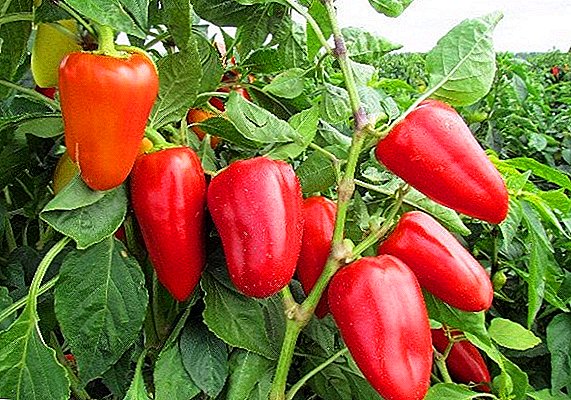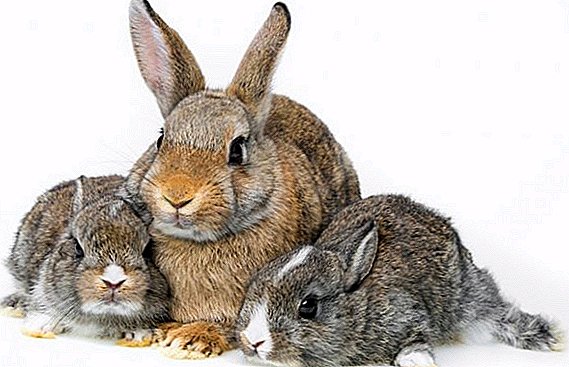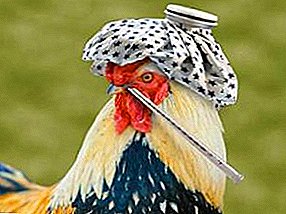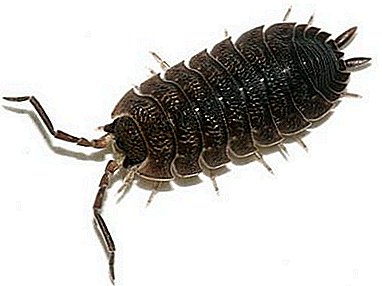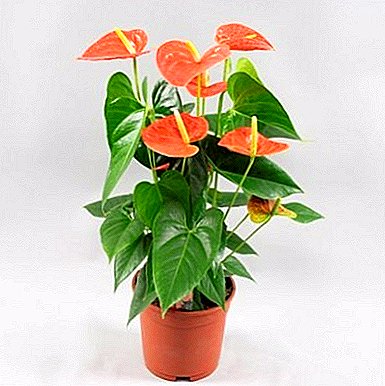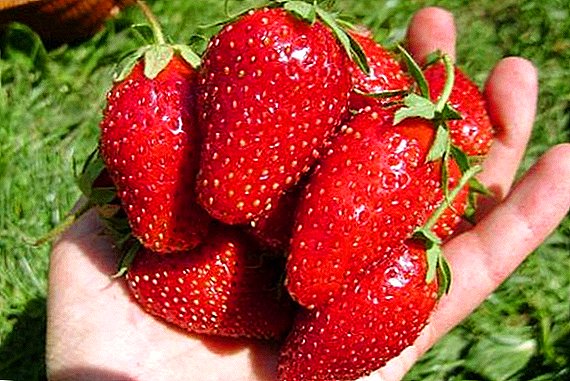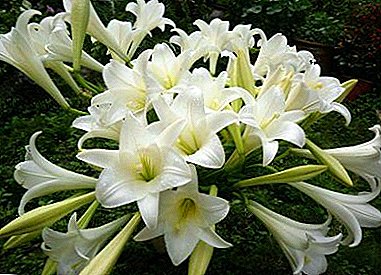
To obtain new copies of this beautiful flower, there are several ways.
The reproduction of lilies is not a difficult process that even an inexperienced florist can cope with if they comply with the technology.
How does lily reproduce? There are various ways of breeding this beautiful flower.
The choice of method depends on what copies you or your friends have. There are several ways, both seminal and vegetative.
Care and reproduction
Bulbs
 The method is used for transplanting lilies.
The method is used for transplanting lilies.
After 4-5 years after planting the flower there is a need to transplant it.
More precisely, this process can be called seeding, since during the growth under the ground nests are formed, consisting of 4-6 bulbs.
Dug out the nest should always be divided, otherwise the lily will stop flowering.
The plant is dug out of the ground at the end of September. The resulting bulbs are separated, treated with a solution of potassium permanganate, dried in the shade.
The roots of the bulbs need to cut 8-10 cm.
After drying, each bulb is planted in a separate well. Already in the second year after division, each instance will bloom. If the formed bulbs are small, then flowering will begin in a year.
Children
 On the basis of the lily stem, small onion-kids are formed.
On the basis of the lily stem, small onion-kids are formed.
If the bulb is planted deep, the number of babies will be quite large.
If it is necessary to breed a variety growing in your area, you can increase the number of such onions artificially.
To do this, remove the flowers from the lily, not letting them bloom. You can also separate the stem with the formed children in the spring and prikopat it in the shade.
TIP: That the plant has got accustomed, it is plentifully watered. With this technique, by the autumn a large onion will form on the stem.
Bullets
 Such material is formed between the stem and the leaves of the lily. They should be collected immediately after flowering.
Such material is formed between the stem and the leaves of the lily. They should be collected immediately after flowering.
Reproduction of lilies with bulbs is an easy way to get a large number of seedlings.
On each flower can be formed from 100 to 150 air bulbechek, each of which is able to give life to a new plant.
Scales
 Lily bulbs have one peculiarity - they are covered with scales on which small onion can be grown - kids.
Lily bulbs have one peculiarity - they are covered with scales on which small onion can be grown - kids.
It is possible to get scales from a bulb when transplanting a plant. Grooves for landings have 20-25 cm.
With the bulbs dug out of the ground, the scales are carefully separated, washed in a solution of potassium permanganate and treated with a fungicide.
Then the scales are placed in an opaque package, peppered with peat or sawdust. The package is placed in a warm room for 8-7 weeks. Then for 4 weeks the temperature is reduced to 17-18 degrees.
During this time, 3-4 new onions are formed on each scale. Thus, one maternal bulb can produce from 20 to 100 new plants.
Formed onion planted in the ground in the spring, by this time they are ready for cultivation in open ground.
Cuttings
 Especially valuable and rare varieties of lilies can be propagated by grafting. For their production are suitable stems and leaves.
Especially valuable and rare varieties of lilies can be propagated by grafting. For their production are suitable stems and leaves.
Stem cuttings. Harvested before the formation of buds. The stem is cut from the plant and cut into segments of 8-9 cm.
The cuts are made at an angle and obliquely place the workpiece in the ground to the level of the upper leaflets.
Landings are regularly watered. After 1-1.5 months, depending on the temperature of the air, bulbs appear in the leaf axils. They can be separated and planted in the soil.
TIP: To increase the number of bulbs on the stem, shallow cuts are made on the underground part of the stem.
Also suitable for breeding leaf stalk with a small piece of the stem. Before flowering, it is cut from the plant and placed in a container filled with soil.
From above the stalk is covered with a transparent cap. Rooting occurs within 4-5 weeks. As soon as the first sprouts appear on it, the workpiece can be moved to the open ground.
Seed method
 Separately, it should be said about getting lilies from seeds. Reproduction of lilies by seeds is suitable for getting new varieties on your plot.
Separately, it should be said about getting lilies from seeds. Reproduction of lilies by seeds is suitable for getting new varieties on your plot.
In addition, it is the most productive method, it allows you to simultaneously receive many instances of plants.
Another advantage of it is the resistance of grown flowers to diseases, because viruses are not transmitted through seeds.
The seed method is the only one for breeding lilies of hybrid varieties, since the bulbs formed do not retain the properties of the parent bulb.
TIP: When choosing seeds, make sure they are fresh before buying, as the germination rate may decrease by 50% in the second year after harvest. In the third year only 5-10% are able to germinate.
If you want to get seeds from specimens growing on your plots, you should learn about the ability to pollinate the variety you grow. There are self-pollinating and artificially pollinated species.
It is also necessary to comply with the technology of collecting seeds. You can not break the boxes until the seeds are ripe. At the same time, if you are late with the collection, the boxes may open up and the seeds will pour out on the ground.
To collect choose a healthy stem. It is necessary to cut it before the onset of frost. Stalk with seed boxes put on paper and leave to dry completely.
If it is already cold, and the boxes are not ripe, the stem is separated from the bulb and placed in a vase with sugar water (a teaspoon per 1 liter). In such conditions, the seeds ripen.
Before sowing, seeds are prepared in a special way to improve their germination. After separation from the box, they are mixed with sand and placed in a refrigerator.
Sowing seeds is carried out in three ways.
In open ground
 This method is suitable for frost-resistant varieties.
This method is suitable for frost-resistant varieties.
It is necessary to choose such a site where bulbous cultures were not previously grown.
The site should not be filled with spring melt water, and the place should be as sunny as possible.
Dig up the soil, free from plant debris. Heavy soils must be supplemented with peat and sand for breathability.
Ridges make high, one meter wide. In the beds do transverse grooves at a distance of 15-20 cm from each other. Seeds are placed in the grooves 2-3 cm deep and sprinkled with a layer of sand. From above crops mulch a layer of humus and foliage.
In boxes for seedlings
 Rare varieties of lilies should be sown in boxes with soil mixture and grown in greenhouse conditions.
Rare varieties of lilies should be sown in boxes with soil mixture and grown in greenhouse conditions.
The substrate is prepared from a mixture of peat, sod land and fine gravel. Seeds sprinkled randomly over the surface and sprinkled with a layer of sand.
Germination temperature - 18-25 degrees. If the temperature is higher, germination is sharply reduced. Shoots appear in 15-25 days.
As soon as the first shoots appeared, you need to ensure that they do not die from the sun and lack of moisture. The shoots of lilies at this moment are most vulnerable. The temperature at this time should be lowered to 15-16 degrees.
In the phase of this leaflet seedlings dive, trying not to damage the delicate roots. After picking, sprout care consists of watering and protection from pests.
TIP: For the prevention of fungal diseases, the sprouts are sprayed with Bordeaux mixture, and protected from chlorophos by aphids.
In jars with a nutrient substrate
 This method is used for poorly germinating varieties.
This method is used for poorly germinating varieties.
To do this, peat and sand are mixed in equal quantities, moistened and filled with a mixture of a glass jar.
Seeds are placed in the substrate, the jar is covered with a polyethylene film and tied up for fixation with an elastic band or thread.
Banks are placed in a warm, bright place. The temperature is maintained around 18-20 degrees.
In 60-90 days, onions grow in the bank. As soon as they become visible through the walls of the cans, the mixture together with the bulbs is poured into plastic bags and placed in the refrigerator.
In this state, onion stored 2 months. After this period, the onion is selected from the soil and planted in the seedling boxes.
In open ground grown from seed bulbs planted in September. Low frost varieties grow in boxes until spring.
Flowering lilies grown in this way begins in the second year.
Regardless of the way you choose to breed lilies, it is not very difficult to do. Each florist, even not experienced, will cope with the process and will be able to get new copies of a beautiful flower for his plot.
Detailed information and advice on choosing a place, rules of Lily transplantation can be found on our website: Lily Transplant.


